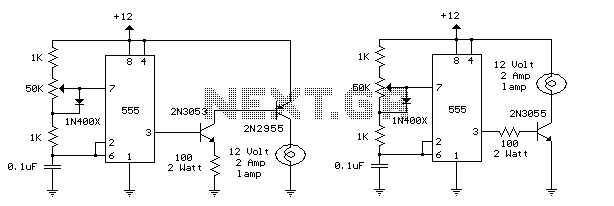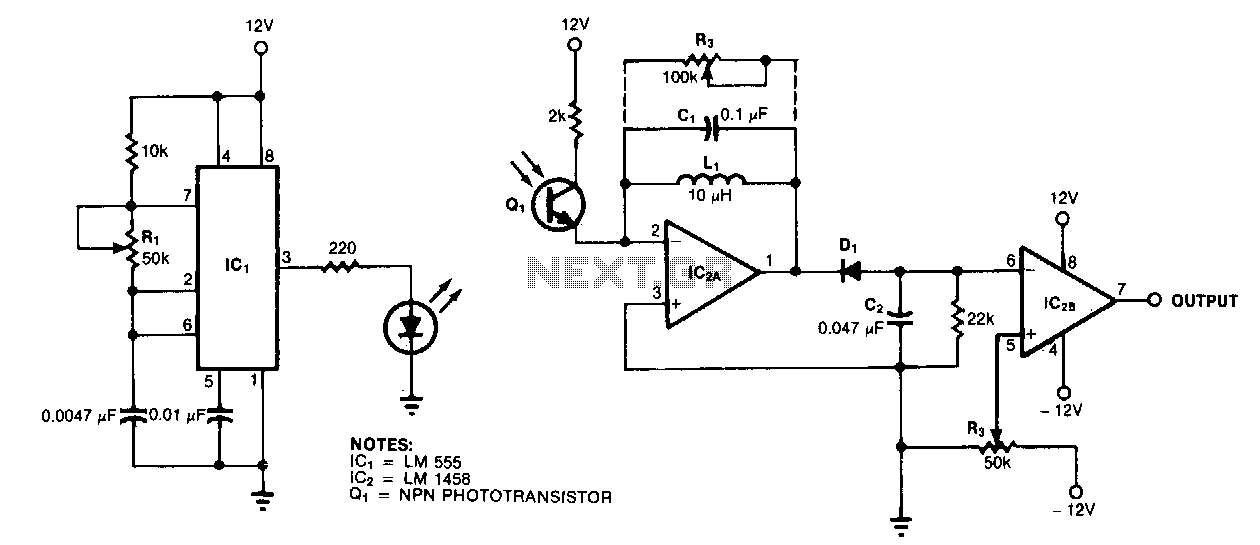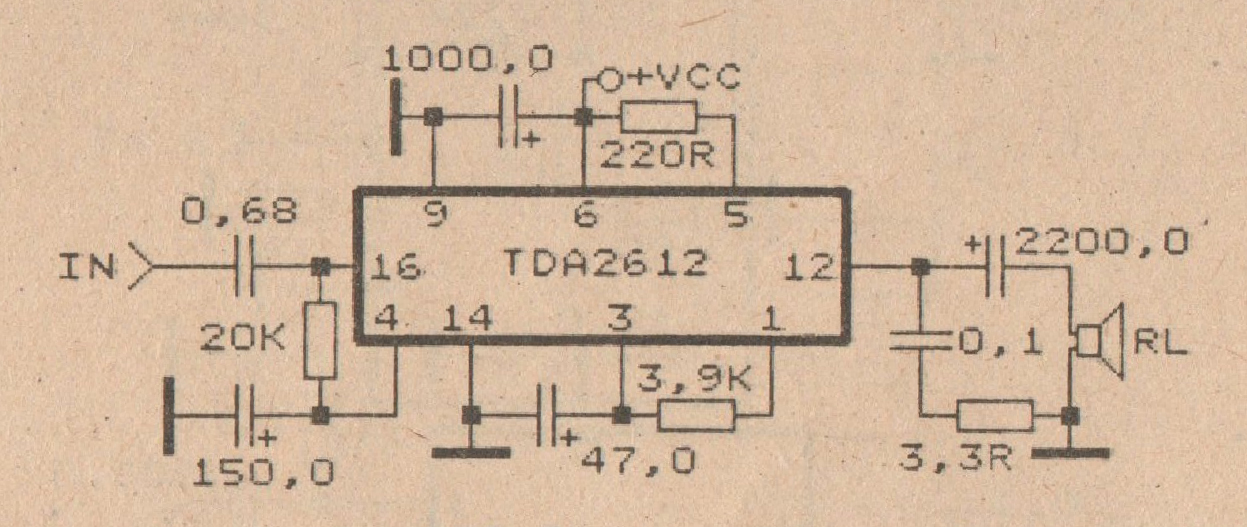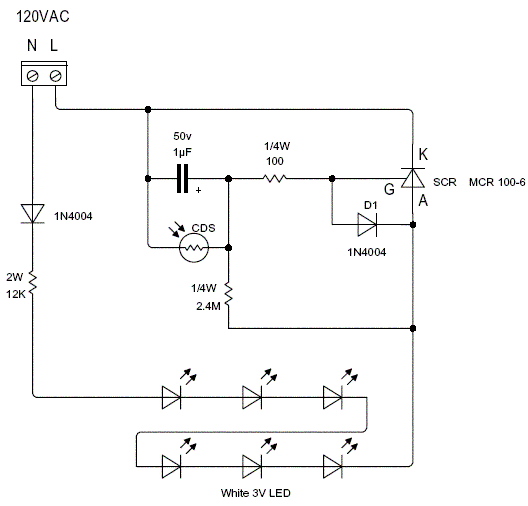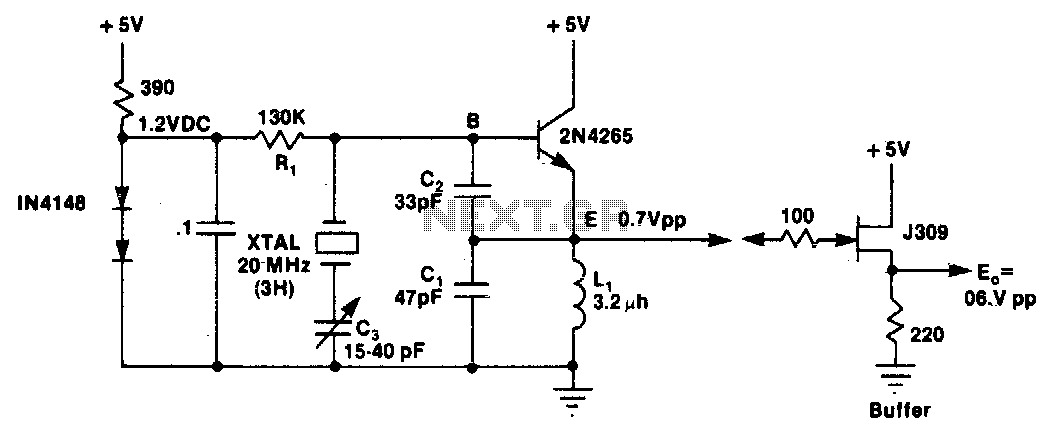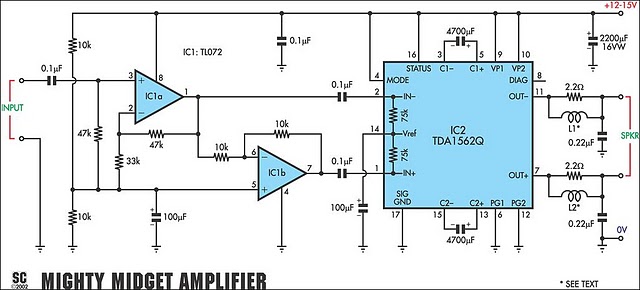
LIGHT SENSITIVE AUDIO OSCILLATOR
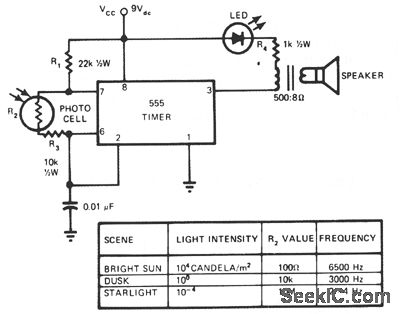
This circuit's frequency of oscillation increases directly with light intensity. The greater the light intensity, the higher the frequency of the oscillator. The 555 timer operates in astable oscillator mode, where frequency and duty cycle are controlled by two resistors and one capacitor. The capacitor charges through R1 and R2 and discharges through R2, which is a standard photo cell. Resistor R3 limits the upper frequency of oscillation to the audio range. The lower range of approximately 1 pulse per second (pps) is set by the value of R2, approximately 10 MΩ, with the photo cell almost totally dark. A loudspeaker provides audio output, and an LED is used as a pilot light that flashes when the frequency falls below about 10 to 12 Hz. The unit is extremely sensitive, especially at the dark end of the photocell resistance range, allowing it to detect lightning from many miles away, providing a rapid frequency increase with each flash of lightning. When used with a flashlight at night, the device functions as a simple optical radar for the blind, indicating the angular direction to a light-reflecting object, as well as height and distance when scanned back and forth. This light-sensitive audio oscillator can also serve as an audible horizontal level device by noting the position of a liquid bubble illuminated by a light source, thereby sensing fluid levels and the vibration state of a fluid surface level.
The circuit utilizes a 555 timer integrated circuit (IC) configured in astable mode, which generates a continuous square wave output. The frequency of oscillation is determined by the charging and discharging time of a capacitor connected to the timing resistors R1 and R2. The incorporation of a photo cell in place of a fixed resistor allows the circuit to respond dynamically to changes in ambient light levels. As the light intensity increases, the resistance of the photo cell decreases, resulting in a higher frequency output from the 555 timer.
Resistor R3 plays a critical role in setting the upper limit of the frequency to ensure that the output remains within the audible range, preventing excessively high frequencies that could be inaudible or damaging to connected components. The audio output is delivered through a loudspeaker, allowing the user to hear variations in frequency that correspond to changes in light intensity. The LED pilot light serves a dual purpose: it provides visual feedback of the circuit's operational status and indicates when the frequency drops below a certain threshold, which could signify low light conditions.
The circuit's sensitivity to light allows for innovative applications, such as detecting distant lightning strikes, where even minimal changes in light can trigger significant frequency shifts. Additionally, the circuit can be employed as a navigational aid for visually impaired individuals, enabling them to identify the direction and proximity of light sources. By sweeping the device across a space, users can discern the location of objects based on the audio feedback produced by the circuit. Furthermore, the design can function as a fluid level sensing device, where the position of a liquid bubble can be monitored through changes in the output frequency, providing a practical solution for measuring liquid levels in various applications.This circuit`s frequency of oscillation increases directly with light intensity. The greater the light intensity, the higher the frequency of the oscillator. The 555 timer operates in the astable oscillator mode where frequency and duty cycle are controlled by two resistors and one capacitor. The capacitor charges through R1 and R2, and discharges through R2, a standard photo cell. Resistor R3 limits the upper frequency of oscillation to the audio range. The lower range of approximately 1 pps is set `oy the value of R2, approximately 10-M ©, with the photo cell almost totally dark. A loudspeaker provides audio output, and an LED is used as a pilot light that flashes when the frequency falls below about 10 to 12 Hz.
Extremely sensitive, especially on the dark end of the photocell resistance range, the unit can detect lightning many miles away, providing a rapid frequency increase with each flash of lightning. When used with a flashlight at night, the device becomes a simple optical radar for the blind, showing angular direction to a light-reflecting object, as well as height and distance to the object when hand scanned back and forth.
This light-sensitive audio oscillator can also serve as an audible horizontal level device by noting the position of a liquid bubble illuminated by a light source. Thus, you can sense fluid levels as well as the vibration state of a fluid surface level. 🔗 External reference
The circuit utilizes a 555 timer integrated circuit (IC) configured in astable mode, which generates a continuous square wave output. The frequency of oscillation is determined by the charging and discharging time of a capacitor connected to the timing resistors R1 and R2. The incorporation of a photo cell in place of a fixed resistor allows the circuit to respond dynamically to changes in ambient light levels. As the light intensity increases, the resistance of the photo cell decreases, resulting in a higher frequency output from the 555 timer.
Resistor R3 plays a critical role in setting the upper limit of the frequency to ensure that the output remains within the audible range, preventing excessively high frequencies that could be inaudible or damaging to connected components. The audio output is delivered through a loudspeaker, allowing the user to hear variations in frequency that correspond to changes in light intensity. The LED pilot light serves a dual purpose: it provides visual feedback of the circuit's operational status and indicates when the frequency drops below a certain threshold, which could signify low light conditions.
The circuit's sensitivity to light allows for innovative applications, such as detecting distant lightning strikes, where even minimal changes in light can trigger significant frequency shifts. Additionally, the circuit can be employed as a navigational aid for visually impaired individuals, enabling them to identify the direction and proximity of light sources. By sweeping the device across a space, users can discern the location of objects based on the audio feedback produced by the circuit. Furthermore, the design can function as a fluid level sensing device, where the position of a liquid bubble can be monitored through changes in the output frequency, providing a practical solution for measuring liquid levels in various applications.This circuit`s frequency of oscillation increases directly with light intensity. The greater the light intensity, the higher the frequency of the oscillator. The 555 timer operates in the astable oscillator mode where frequency and duty cycle are controlled by two resistors and one capacitor. The capacitor charges through R1 and R2, and discharges through R2, a standard photo cell. Resistor R3 limits the upper frequency of oscillation to the audio range. The lower range of approximately 1 pps is set `oy the value of R2, approximately 10-M ©, with the photo cell almost totally dark. A loudspeaker provides audio output, and an LED is used as a pilot light that flashes when the frequency falls below about 10 to 12 Hz.
Extremely sensitive, especially on the dark end of the photocell resistance range, the unit can detect lightning many miles away, providing a rapid frequency increase with each flash of lightning. When used with a flashlight at night, the device becomes a simple optical radar for the blind, showing angular direction to a light-reflecting object, as well as height and distance to the object when hand scanned back and forth.
This light-sensitive audio oscillator can also serve as an audible horizontal level device by noting the position of a liquid bubble illuminated by a light source. Thus, you can sense fluid levels as well as the vibration state of a fluid surface level. 🔗 External reference
